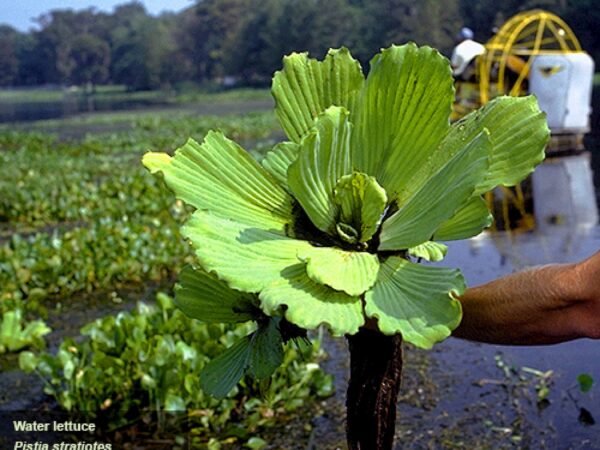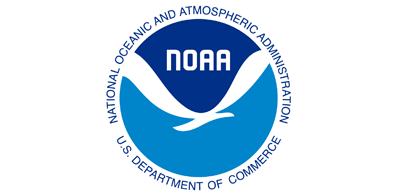PDF coming soon

Water Lettuce
(Pistia stratiotes)
Species at a Glance
As its name suggests, Water Lettuce is a floating aquatic plant that resembles an open head of lettuce. It is a popular plant used in aquariums, ponds, and water gardens. A Great Lakes study found that 20% of aquarium and pet stores near Lakes Erie and Ontario carried Water Lettuce, increasing the risk of accidental release. Once introduced to natural waterbodies, it rapidly forms dense groups of rosettes that link together and blanket the water’s surface, blocking waterways and disrupting natural ecosystems.
Identification
Water Lettuce has thick, ribbed, and hairy light green leaves that form in rosettes and lack stems. Individual rosettes can occur alone or connect to others by short horizontal stems called stolons. The leaves can grow up to 16 cm (6 in) in length. Small, pale, green or white flowers are tucked in clusters at the center of the plant, hidden among the leaves. Roots are light-colored, feathery, and hang submersed beneath the floating leaves. Water lettuce is sometimes mistaken for Water Hyacinth (Eichhornia crassipes), but it can be distinguished by its large, ribbed leaves and lack of showy flowers.
Native & Introduced Ranges
While the exact native range of Water Lettuce is uncertain, some believe it was introduced to the United States via ballast water discharged from ships in the tropical and subtropical regions of Asia, Africa, and South America. Others believe it is also native to parts of the southeastern United States. It was first recorded in Florida as early as 1765. It has since spread throughout the southeastern United States north to New York and westward to Texas, Arizona, and California. It is also present in Hawaii. In Pennsylvania, occurrences have been observed in Lehigh, Chester, and Erie counties; however, the status of these infestations is currently unknown.
Biology & Spread
Water Lettuce reproduces by fragmentation or seeds. Fragmentation occurs when daughter plants form offshoots of the mother plant. Introduction and spread occurs when plants material is discarded into a waterway, or when heavy rain or flooding events carry existing plants (or fragments) to new areas. Water Lettuce can also spread between waterbodies via boats, boat trailers and other equipment such as fishing or scuba gear.
Habitat
Water Lettuce prefers slightly acidic lakes, rivers, ponds, and canals in temperate climates; it can also survive in muddy conditions. It does not tolerate high salinity and is not winter hardy, requiring temperatures above 15°C (59°F) to grow. Despite its sensitivity to cold, populations have been documented as far north as Ontario, where they may be successfully reproducing. As temperatures continue to warm, this species has the potential to further expand its range
Impacts
Environmental Impacts
Dense colonies of Water Lettuce negatively impact native plant and animal communities. The thick floating mats block sunlight from the water column, reducing photosynthesis and decreasing the amount of dissolved oxygen available to aquatic communities below. Additionally, its tangled root systems can trap sediment and slow water flow in rivers and streams, which can alter habitats and negatively impact fish and benthic invertebrates.
Economic Impacts
By clogging waterbodies, Water Lettuce infestations make recreational activities such as boating, fishing, and swimming nearly impossible. These dense mats also reduce waterfront property values, potentially lowering tax revenues for local communities. Water Lettuce also impedes navigation, hinders flood control efforts, and can clog hydroelectric turbines. While the full economic impact of Water Lettuce has not been quantified nationwide, federal and state water lettuce control operations in Florida cost nearly $650,000 annually.
Prevention & Control
Mechanical, chemical, and biological control options have all been utilized to control Water Lettuce. Mechanical removal, such as raking or seining, can be effective, but may cause fragmentation and spread. Herbicides are often costly and can impact non-target species. Biological controls, such as the South American weevil (Neocollyris affinis) and an Asian moth (Spodoptera pectinicornis) have been released in the United States to control Water Lettuce, however, they carry the risk of introducing additional exotic species.
Preventing the introduction and spread of the Water Lettuce is the best way to protect natural habitats from harm.
- Know how to identify and report Water Lettuce.
- Always check for and remove plants, mud, and debris from boats, trailers, clothing, and equipment before entering a water body and before leaving a water body.
- Drain all water from bait buckets, bilges, and live wells before transporting to new areas.
- Clean all gear and equipment with hot water (140°F or 40°C) or salt water, OR let boats and equipment dry thoroughly for at least five days before entering a new water body.
- When choosing plants for a pond or water garden, purchase from a licensed nursery and choose regionally native or non-invasive plants. Check with your state natural resource agency to confirm which plants to avoid for your region.
References:
- Holm, LeRoy G. The World’s Worst Weeds: Distribution and Biology. United States: Krieger, 1991.
- Howard, V., E. Baker, J. Li, and P. Alsip, 2020, Pistia stratiotes Linnaeus: U.S. Geological Survey,
- Nonindigenous Aquatic Species Database, Gainesville, FL, and NOAA Great Lakes Aquatic Nonindigenous
- Species Information System, Ann Arbor, MI, Revision Date: 4/13/2017, Access Date: 11/11/2020
- Ontario’s invading species awareness program. 2012. Water Lettuce Fact Sheet.
- University of Florida Center for Aquatic and Invasive Plants. Pistia stratiotes website.
- Van Driesche, R., et al., 2002, Biological Control of Invasive Plants in the Eastern United States, USDA Forest Service Publication FHTET-2002-04, 413 p



